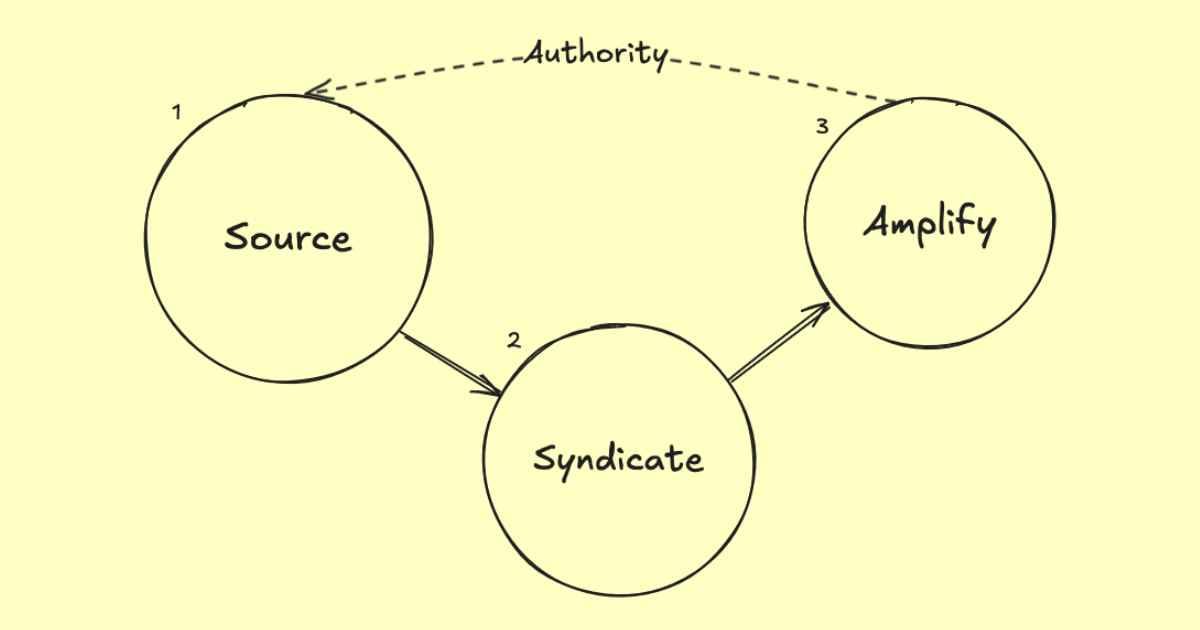The Canonical Cascade Model
A 3-layer strategy (Source, Syndicate, Amplify) to publish content that builds authority with people, search engines, and LLMs.

The Canonical Cascade Model is a 3-layer strategy for content distribution. It’s designed to maximize authority, reach, and impact by sending convergent signals to human readers, search engines, and LLM-based systems.
The model consists of three layers:
- Source Layer: Publish original content first to a canonical source you own (your website) using full SEO, structural, and trust-building best practices.
- Syndication Layer: Distribute excerpts and links back to the Source via core channels like email, RSS, and professional networks to notify your audience and build immediate signals.
- Amplification Layer: Repurpose the core ideas into native formats (video, slides) and engage with new audiences in relevant communities to expand reach.
⚡ Summary Table for Mapping
Use this table to map your content, channels, and layers.
| Layer | Purpose | Action |
|---|---|---|
| 1. Source | Own & establish authority | Publish Source |
| 2. Syndication | Notify & create signals | Link to Source |
| 3. Amplification | Expand reach & engage | Adapt Source |
This model defines three distinct layers for content distribution, moving from a central source of truth outwards to broader audiences. Each layer has a specific purpose, set of channels, and measure of success.
🏠 Layer 1: Source
This is the core of your digital identity and the canonical source for all your authority content. It is the single point of origin.
Primary Channel
Your main website or blog.
Definition
The Source Layer is a digital "home base" that acts as the single source of truth (SSOT) and definitive canonical reference for your Source Content and information. It is the primary domain where you establish expertise and controls the narrative as owned media.
Purpose
- To own your content on a platform you control
- To establish algorithmic authority (SEO, LLM) and human trust
- To serve as the permanent, linkable archive for all original material
Key Actions
- Publish all original content (Source Content) here first
- Implement full technical, SEO, and LLM best practices (semantic HTML, clean URLs, schema.org, sitemaps, RSS feeds, fast load times)
- Write for people-first and include trust signals (author bios, credentials, social proof)
- Ensure it's crawlable and accessible
Best Practices
- Own your platform: Use open-source or self-hosted solutions where possible to ensure full control over design, data, and future access.
- Prioritize performance: Ensure the site meets Google's Core Web Vitals. Fast-loading pages are rewarded by users and algorithms alike.
- Implement LLM Content Best Practices: Use clear, semantic HTML (
<article>,<h2>), provide anchor links for sections, and format key data in simple tables for easy extraction by AI. - Build trust visibly: Every article should have a clear author bio with credentials. The site should feature social proof like testimonials, case studies, or media mentions.
🌐 Layer 2: Syndication
This layer is about immediate, structured distribution. Its function is to inform your core, existing audience and to signal to algorithms that new content has been published on the Source Layer.
Primary Channels
- Direct Audience: Email newsletters (Substack, Medium, …)
- Real-time Feeds: Fediverse, RSS Aggregators
- SEO Surface: Medium (with canonical URL set in ‘Advanced’ settings), …
Definition
The Syndication Layer consists of channels where excerpts, abstracts, or notifications of the original content are published and pushed. Every post in this layer must link directly back to the canonical URL on the Source Layer. This is a mix of owned and earned media, and and is the “Syndicate Elsewhere” component of IndieWeb’s POSSE.
Purpose
- Reach: Instantly/quickly notify your most engaged, direct audience
- Signaling: Create immediate backlinks and social signals that point algorithms to the Source Content.
- Discovery: Surface the content in feeds where your audience already spends time
Key Principle
Link back, don't recreate. The goal is to drive traffic to the Source, not create competing versions of the content.
Best Practices
- Automate Where Possible: Use tools like RSS-to-email or n8n to automatically trigger syndication when Source content is published.
- Don’t post the full text without Canonical: Use excerpts, abstracts, or a compelling summary if you can’t set the canonical. This avoids algorithmic/SEO penalties and drives clicks back to the Source content.
- Set the Canonical URL: When using platforms like Medium, always use it to ensure the canonical link is set correctly. This prevents algorithmic duplicate content penalties.
- Tailor the hook: Customize the introductory text for each channel. Like a professional tone for LinkedIn, a conversational one for the Fediverse, and a clear, direct subject line for email.
🔊 Layer 3: Amplification
This layer is about strategic repurposing and community engagement. It happens after initial syndication and is designed to reach new, adjacent audiences by adapting the content to fit different platforms and contexts.
Definition
The Amplification Layer consists of channels where the core ideas of the Source content are repurposed (atomized) into new formats or used as a basis for community engagement. This activity typically occurs 2-14 days after initial publication and is primarily earned media.
Purpose
- Audience Expansion: Reach people who may not follow your Source or Syndication channels
- Engagement: Generate discussion and demonstrate expertise in relevant communities, following EEAT guidelines & best practices
- Content Velocity: Give your core ideas more longevity and surface area by adapting them to different consumption habits (video, audio, visual, live, …)
Key Principle
Adapt and engage. The goal is to re-imagine the content for a new context and participate in the resulting conversation.
Sub-Layers
- Community Engagement (48-72 hours later)Manually share the original link with context in relevant, high-context communities. The value comes from the discussion you engage in around the link.
Channels: Hacker News, relevant Subreddits, Indie Hackers, Cozy Web, … - Content Repurposing (1-2 weeks later)Transform the original content's key takeaways into new, native assets for different platforms. All repurposed content should reference or link back to the original Source content.
Channels & Formats:- Short-form Video: YouTube Shorts, Instagram Reels, TikTok.
- Visuals/Slides: LinkedIn Carousels, Instagram Posts.
- Audio: Podcast snippets on Spotify, Apple Podcasts.
Best Practices
- Go Native: Repurpose content into formats native to the platform (vertical video for Reels/Shorts, carousels for LinkedIn/Instagram). Don't just post a link to your blog.
- Engage Authentically: When posting in communities, don't just "drive-by" drop a link. Provide context, ask a question, and stick around to participate in the comments. Your engagement is as important as the content itself.
- 80/20 Rule (Pareto Principle): Aim for a mix where 80% of the value is delivered directly on the platform (the key takeaways in your carousel) and 20% is the call-to-action to visit the Source for more detail.
- Link Strategically: In repurposed content, the link back to the Source should feel like a natural next step for someone who wants to go deeper, not a required click.
🎬 When the Source content isn't on your website
Sometimes, the primary source content (Source) is inherently tied to a third-party platform, like a video on YouTube, a podcast uploaded to Spotify, or music shared through a publishing platform.
In these cases, the model adapts slightly:
- The platform is the Media Source: The YouTube channel or podcast feed becomes the de facto Source Layer for that specific media format. It is the canonical source for the video or audio file.
- Your website is the Meta Source: For each external media asset, create a corresponding post on your main website. This post acts as the central, text-based reference point.
- Embed the media directly at the top of the post.
- Add significant value around it: a full transcript, detailed show notes, key takeaways, links to resources mentioned, and expanded commentary.
- All links point to your Source Layer: In your Syndication and Amplification layers, link back to the post on your source layer/website, not directly to the YouTube or Spotify page.
This strategy ensures you still own the canonical, searchable, and linkable text-based asset, which drives SEO and captures authority, while leveraging the discovery engines of major media platforms.
🔗 References & Sources
This model pulls from several established principles in digital content and strategy:
- POSSE (Publish on your Own Site, Syndicate Elsewhere)
A concept from the IndieWeb movement emphasizing content ownership as the primary step. - Hub and Spoke Model
A widely used content marketing strategy (and information pattern) where a central "hub" piece of content is supported by numerous "spoke" assets that link back to it. - Content Atomization (aka Repurposing)
The practice of deconstructing a large piece of content into smaller, contextually relevant pieces for different platforms. - POEM (Paid, Owned, Earned Media)
A framework for categorizing media channels. - E-E-A-T Guidelines
A set of quality guidelines used by Google to evaluate content.

Discussion